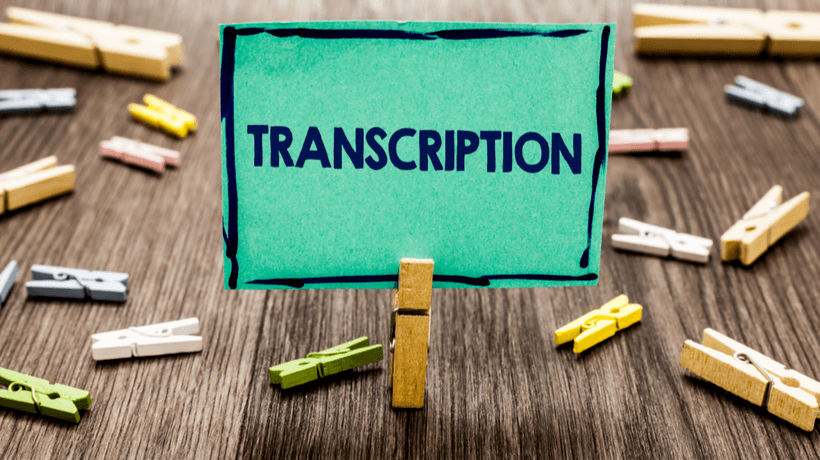Video Transcription For The eLearning Industry
Many of us have spent a good part of the past year in video conferences. They all blend into each other—eCourses, webinars, virtual conferences. We jump from one into the other. At the end of the day, it’s a long blur. What happened? What do we remember? Sure, many video conference platforms can record our online courses and meetings. But who has the patience to go through hours of recordings to find something that was said, or to review the essential content transmitted in the video? We’ll focus here on the ways tools and services can be used to transcribe video to text for the eLearning industry.
1. Video Transcription Is Just Minutes Away
Transcribing a video traditionally was a slow, painful, and cumbersome process. Sure, you could stick an intern in a corner with a videotape and headphones and let them plod through the recording. It might take a few enervating hours for each course or meeting, but at least it was cheap. Now, however, there are lots of automated options to transcribe videos. These include video transcription services from professional agencies, video transcription software, freelancers, and more. According to Ofer Tirosh, CEO of Tomedes, notes that video to text transcription, even as performed by a leading language services agency, is a whole lot faster than before, at a cost not much higher than an intern’s hourly wage.
2. Video Transcription Should Be A Part Of Each Lesson Or Meeting
Why wouldn’t you want to transcribe a video to text? Two answers come to mind. One is if something confidential or regrettable was transmitted in the meeting or webinar or conference or course. Of course, you still might want to preserve everything else, or perhaps you would want to keep even the secret stuff “for the record.” In legal transcripts, of course, content like names and private information is routinely redacted for published versions. But someone has the unredacted version of the video, and the transcript and that version have essential value. Transcription is also great for Search Engine Optimization (SEO).
3. Video Transcription Can Be Done By Machines, But At Your Own Risk
Video-to-text transcription and audio-to-text transcription have advanced by leaps and bounds in recent years as AI has improved the quality of speech recognition. But, as anyone who has used the speech-to-text transcription software can attest, it’s far from flawless. Even accuracy at the 90% level means a high level of re-do is required. That’s even under optimal conditions, but poor recording quality, background noise, multiple speakers, and multiple languages can cause havoc in a transcript. Sorting out the mess can take more time than trying to transcribe “manually.”
Interestingly, the education industry has lower expectations about the increased usage of automated transcription than other industries. Whereas an absolute majority of respondents in the marketing research, marketing, and media/entertainment expected usage to increase in their fields, only 38% of respondents in education felt this, equal to those who had no such expectation.
4. Transcription Costs Are Manageable But Watch Out For Surcharges
The quality of auto-transcription tools varies widely. Some are free, and some are priced according to the duration of the video (or audio) clip. For example, the base rate may be, say, a dollar per minute, so a 15-minute clip would cost $15. But watch out for rush charges, or surcharges for “verbatim” transcriptions, which is when every er, um, and stutter is transcribed in all its glory. “Edited” transcriptions, in which the verbatim text is smoothed and fixed to make it more comprehensible, may also have a surcharge. You need to do your research about the various options, though there are some good and objective reviews of transcription software out there.
5. Hybrid Video Transcription Offers The Best Blend For Costs And Accuracy
Unless and until video transcription reaches the accuracy of an expert human transcriptionist, it will require human supervision. Sometimes that involves securing multilingual expertise, sometimes it just takes a trained ear gifted at understanding the spoken word. So professional transcription, as practiced by top agencies, is a two-step process: first a pass by AI-driven speech-to-text software and then polishing and proofing by a trained transcriptionist, who can distinguish homonyms and homophones.
Ultimately, you’ll need to strike a balance between all-machine and all-human extremes. A blend of the two approaches makes sense, whether provided by a professional agency or set up in-house. It makes sense to auto-translate a video course with software, but you will need to invest in a human operator to fill the holes, resolve the gibberish, and provide the proofreading you and your students expect. The result is faster than a transcriptionist alone and less costly than relying exclusively on people.
4 Tips And Tricks
Ready to get started? Here are some tips and tricks to make transcription more efficient:
- Learn how to format and present transcriptions
Know how to add comments and annotations, timestamps, reduce background noise, and improve audio quality. There are templates available for this, or you can make your own and reuse them. - Set up the tools and accessories to make transcription easier
Transcription software has various ways to do basic functions efficiently, like playing or pausing, or advancing to a particular point in the video. Aids include keyboard shortcuts or foot-pedals to leave the transcriptionist’s hands free. - Set up macros and text expanders
Most transcription software lets you substitute short abbreviations for frequently used names and phrases, a bit like autofill or autocorrect, but with the ability to define and maintain a reusable glossary of the shortcuts. For example, “edn” can expand to “education” and “tlw” to “teleworking.” - Consider outsourcing proofreading
Often this will require using a transcriptionist who knows the jargon and terminology of the video content, so industry-specific language is understood and rendered correctly. If you have such resources in-house, use them. Otherwise, contract a service provider with specialist transcriptionists knowledgeable in the relevant field.









